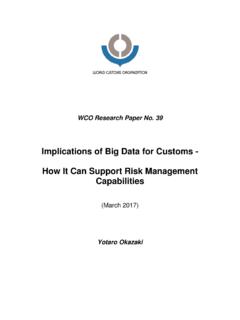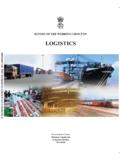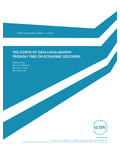Transcription of The Author(s) 2016 safety-related risk in the upstream oil ...
1 Original ArticleUsing big data to managesafety- related risk in theupstream oil & gas industry :A research agendaKim Hua Tan1,V ctor G Ortiz-Gallardo2andRobert K Perrons3,4 AbstractDespite considerable effort and a broad range of new approaches to safety management over theyears, the upstream oil & gas industry has been frustrated by the sector s stubbornly high rate ofinjuries and fatalities. This short communication points out, however, that the industry may be in aposition to make considerable progress by applying big data analytical tools to the large vol-umes of safety- related data that have been collected by these organizations. Toward making thiscase, we examine existing safety- related information management practices in the upstream oil &gas industry , and specifically note that data in this sector often tends to be highly customized,difficult to analyze using conventional quantitative tools, and frequently ignored. We then contendthat the application of new big data kinds of analytical techniques could potentially reveal patternsand trends that have been hidden or unknown thus far, and argue that these tools could help theupstream oil & gas sector to improve its injury and fatality statistics.
2 Finally, we offer a researchagenda toward accelerating the rate at which big data and new analytical capabilities could play amaterial role in helping the industry to improve its health and safety & gas, safety, big data , health, safety, and environment1 Nottingham Business School, Jubilee Campus, Nottingham, UK2 Mexican Petroleum Institute, Mexico City, Mexico3 Queensland University of Technology, Brisbane, Queensland, Australia4 Centre for Strategy and Performance, University of Cambridge, Cambridge, UKCorresponding author:Robert K Perrons, Queensland University of Technology, GPO Box 2434, Brisbane, QLD 4001, : Exploration & Exploitation0(0) 1 8!The Author(s) 2016 Reprints and : a broad range of ideas and approaches over the years to improve its health andsafety performance ( , Cramwinckel and Thummarukudy, 2000; Flin et al., 1996), theupstream oil & gas industry has found it difficult to reduce stubbornly high fatality andinjury rates among personnel (Curlee et al.)
3 , 2005). In 2012, there were a total of 138 fatalitieswithin the sector in the United States alone (King, 2013) and, because of the uncommonlyglobal nature of the industry (Goldstein, 2009; Hatakenaka et al., 2006; Yergin, 1991), thisunfortunate trend extends throughout the sector s operations around the world. By com-parison, the industry s on-the-job fatality rate in the United States is approximately timeshigher than the national average (King, 2013).A major part of the oil & gas industry s strategy toward mitigating these kinds of health,safety, and environment (HSE) incidents is to measure them in impressive detail. Vastamounts of data have been collected about these accidents (Veley, 2002) in the hope thatthis will improve the sector s ability to spot trends and discover patterns that can shed lighton potential solutions. But early attempts at finding these high-level trends have beenthwarted by three factors. First, although some of the industry s HSE data have beencoded and categorized into numerical data such as lost-time incident statistics, much of ithas been captured as written responses that were later converted to text (Campbell et al.
4 ,2012). Second, a significant fraction of this historical data resides within highly customizedapplications and bespoke files whose structures are relatively unique. As DeVol (2004) sug-gests, many of the people collecting this data had torely on either custom-built data systems or use a system of e-mails and spreadsheets or simplestandalone database applications for HSE incident reporting and information injury, environmental, property/equipment damage, and vehicle incident report-ing with medical case management, industrial hygiene monitoring, auditing and inspections,investigation results with corrective actions and insurance claims management into a singleintegrated system was not possible or worth the investment to build (1).Third, the highly customized and fragmented nature of HSE data within the sector hascreated a problem that one operator refers to as dark data that is, information collectedduring the course of business that remains in archives that frequently do not garner muchattention, or that are not generally accessible or structured sufficiently for analysis (Akoumand Mahjoub, 2013).
5 This article explains how new tools and approaches unfolding within the big data revo-lution could be applied to data within the upstream oil & gas industry , and puts forward fivespecific research questions that, if answered, could materially improve the sector s data and its applications for managing industrial risksLarge data sets captured by digital devices and application software have been successfullyused by managers to gain valuable insights into market, product, and consumer behavior(Mayer-Scho nberger and Cukier, 2013). Many firms have been able to leverage big data toincrease operational efficiency, inform strategic direction, bring about better customerservice, develop new products and services, and identify new markets (Demirkan andDelen, 2013; Fulgoni, 2013; Lohr, 2012a). These data -driven decisions have, in turn, enabled2 Energy Exploration & Exploitation 0(0)firms to create new and inventive types of competitive advantage for themselves (Davenportet al.)
6 , 2012).There are also clear opportunities for firms including many of those in the oil & gasindustry to leverage big data and predictive analytics to mitigate operational kinds of now recognize the need to understand and reduce risks to infrastructure, indus-trial operations, and the supply chain. big data and its related technologies can potentiallyact as a catalyst to transform the scientific use of environmental information so that it can beapplied toward risk mitigation. Table 1 shows the list of big data applications in riskmitigation reported in the complementary technologies have also recently made impressive gains that arealready starting to make significant impacts in how large volumes of data can be collectedto manage industrial risks . In recent years, there has been a proliferation of new wearabledevices such as watches, rings, glasses, and heads-up displays for consumers (Griffith, 2014).These wearable devices will enable experts to help less experienced industrial workers in oil &gas operational settings all around the world.
7 For example, a relatively inexperienced workerat an oil & gas operating facility can wear special safety glasses equipped with a camera,Table of big data risk mitigation examplesReferencesManufacturing operationsRaytheon uses built-in sensors on assets tohave a real-time monitoring of manu-facturing assembly operations. Forexample, only qualified operators areallowed to carry out certain ensure quality and reduce operationsrisks, the sensor will also limit thenumber of screw turns for certainassembly and Trent (2014)LogisticsGlobal courier company DHL uses BigData for early detection of potentialrisks (weather conditions, influenzaoutbreaks) in supply chains. DHL pro-vides customers with an overview ofpotential disruptions of their individualsupply et al. (2013)Supply chainCisco uses big data to integrate riskawareness into the product and thevalue chain. The approach enables Ciscoto anticipate emergencies by protectingimportant segments of the supply chainwith built-in resiliency and levers to pullwhen a disruption enz and Revilla (2014)Oil & gasA hands-free checklist, which workers canfollow while they are assembling equip-ment, can save time and reduce risksarising due to (2014)Tan et , speaker, and wireless antenna to send via live data feed information about theirsurroundings and the system around them to some kind of central command center staffed byseasoned veterans.
8 The more experienced personnel can then advise their less experiencedcolleagues on the specifics of their situation, thereby imparting the wisdom and experienceof the more senior staff member without actually having them physically present at the the industry s big data agenda toward HSEBy most accounts, the oil & gas industry s data are already big. Modern oil & gas seismicdata centers can easily contain as much as 20 petabytes1of information, which is roughlyequivalent to 926 times the size of the Library of Congress (Beckwith, 2011). And whilethe industry s seismic data sets have been notoriously large and cumbersome for a long time,many of the operational aspects of the oil & gas industry are also generating significantlymore data than they used to (Perrons, 2010).Like many industries, the upstream oil & gas sector has seen a flurry of initiatives andhigh-profile publications (Anand, 2013; Beckwith, 2011) about big data , which have in turntranslated into significant discussion about this topic within industry conferences ( ,Feblowitz, 2013) and among practitioners.
9 Critics of big data caution that the transform-ational potential of these analytical capabilities may be somewhat oversold and misunder-stood (Harford, 2014; Lohr, 2012b),2but the oil & gas sector has already been noticeablyimpacted by several of the technologies underpinning these changes ( , Perrons andJensen, 2015).However, these inroads have largely been focused on more technical parts of the businesssuch as reservoir characterization and drilling optimization (Akoum and Mahjoub, 2013;Holdaway, 2014). With the notable exception of a handful of extremely high-level conferencepapers (Batterson and Iovino, 2014; Pettinger, 2014), there have been few significant inroadsin the application of big data specifically to the HSE- related parts of the industry . Wetherefore submit:Research Question 1: What barriers technical, economic, or organizational need to be over-come for big data technologies to be applied to the oil & gas industry s HSE- related challengeswith the same sense of urgency seen in more technical parts of the sector?
10 Also, because big data and cloud computing are highly interconnected technologies that areevolving in parallel (Bochman, 2013; Bughin et al., 2010), the upstream oil & gas sector stepid advances toward the cloud (Perrons, 2015) are also highly relevant to its evolutionarytrajectory with regards to big data . Companies in the industry have made relatively modestinroads into cloud computing by frequently preferring private clouds instead of public ones(Feblowitz, 2011; Perrons and Hems, 2013) or opting for hybridized solutions that mix cloudand existing non-cloud IT resources (Mathieson and Triplett, 2011). We believe that thisparticular obstacle is sufficiently important to warrant:Research Question 2: How will the oil & gas industry s relatively slow adoption of cloud com-puting impede its uptake of big data technologies, and what can be done about it?Also, the recurring problem of custom-built data systems and spreadsheet-based databasesfor HSE reporting have created a highly fragmented body of data (DeVol, 2004) that isdifficult to consolidate into the massive data sets that have revealed new and insightfulrelationships in other parts of the marketplace.







